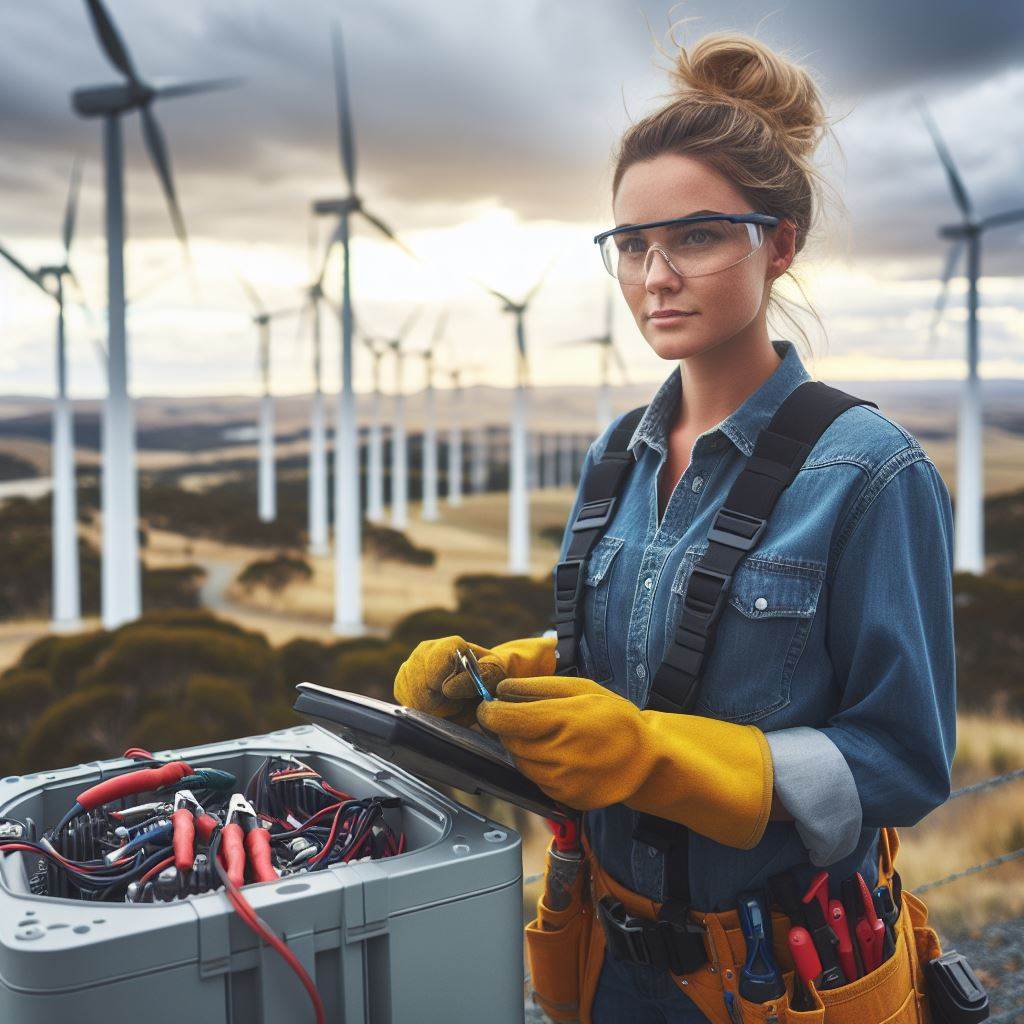Introduction
Green energy refers to renewable sources such as solar, wind, and hydroelectric power.
Green energy is crucial in Australia due to its abundant natural resources and commitment to sustainability.
This blog post aims to explore how Aussie energy experts are leading the way in green energy development.
Green energy, also known as renewable energy, is derived from natural sources such as sunlight, wind, and water.
It is a sustainable and clean alternative to traditional fossil fuels, which contributes to reducing greenhouse gas emissions and mitigating climate change.
In Australia, green energy plays a vital role due to the country’s abundant renewable energy potential.
Australia has vast areas with high solar irradiation, strong wind resources, and potential for hydropower generation.
Recognizing the importance of reducing carbon emissions, Australia has made significant strides in harnessing these resources to meet its energy needs.
The purpose of this blog post is to highlight the achievements and innovations of Australian energy experts in the field of green energy.
By leveraging their expertise and technological advancements, these professionals have been leading the way in transitioning Australia’s energy sector to a more sustainable and environmentally friendly future.
Throughout this section, we will explore various initiatives and projects undertaken by Australian energy experts.
From large-scale solar farms and wind power installations to innovative battery storage solutions, these endeavors demonstrate Australia’s commitment to a greener and more renewable energy landscape.
By showcasing Australia’s success in green energy development, we hope to inspire and educate readers on the potential of renewable energy sources.
Through continued efforts and investments in clean energy technologies, Australia’s energy experts are helping to pave the way towards a more sustainable future for the nation and the world.
Read: Certifications for Engineering Techs in AU
Green Energy in Australia
A. Current state of green energy adoption in Australia
- Australia is making significant progress in adopting green energy solutions.
- The country has abundant renewable energy resources, including solar, wind, and hydro power.
- Currently, renewable energy sources account for approximately 21% of Australia’s total electricity generation.
- Solar energy is the most widely adopted renewable energy source in Australia, with over 2 million solar power systems installed across the country.
B. Government initiatives and targets for renewable energy
- The Australian government has set ambitious targets to increase the use of renewable energy.
- The Renewable Energy Target (RET) aims to ensure that 33,000 gigawatt hours of Australia’s electricity comes from renewable sources by 2020.
- The government offers financial incentives and subsidies to encourage households and businesses to invest in renewable energy systems.
- Various state governments have also implemented renewable energy targets to further promote green energy adoption.
C. Role of electric engineers (EEs) in advancing green energy
- Electric engineers play a crucial role in transforming Australia’s energy landscape towards sustainability.
- EEs design, develop, and maintain renewable energy systems, such as solar panels, wind turbines, and hydroelectric power stations.
- They ensure the efficient generation, transmission, and distribution of green energy.
- EEs also work on improving energy storage technologies to address the intermittent nature of renewable energy sources.
- They collaborate with researchers, scientists, and policymakers to innovate and implement new green energy solutions.
- EEs contribute to the development of smart grids and energy management systems, optimizing the integration of renewable energy into the existing infrastructure.
- Through their expertise, EEs help identify and overcome technical challenges associated with green energy adoption.
- They contribute to the improvement of energy efficiency and reduction of greenhouse gas emissions.
- EEs’s innovative ideas and research drive the continuous evolution of renewable energy technologies.
- Their contribution is key to achieving government targets and ensuring a sustainable and clean energy future for Australia.
In short, Australia has made significant progress in adopting green energy solutions.
The government’s initiatives and targets have led to a substantial increase in renewable energy generation.
Electric engineers play a crucial role in advancing green energy by designing and developing renewable energy systems, improving energy storage technologies, and contributing to the development of smart grids.
Their expertise and innovation are essential in achieving a sustainable and clean energy future for Australia.
Read: Aussie Techs: Balancing Field & Office Work
Find Out More: Engineering Tech Salaries in Australia 2024
Leading Aussie EEs in Green Energy
A. Overview of Aussie EEs at the forefront of green energy
Australian electrical engineers (EEs) are taking the lead in revolutionizing the green energy sector.
With their expertise and innovation, they are paving the way for a sustainable future.
B. The achievements and contributions of individual EEs
- Example 1: EE’s work in developing solar energy systems: Aussie EEs have played a crucial role in the development of efficient solar energy systems.
Their research has led to advancements in photovoltaic (PV) technology, making solar power a viable option. - Example 2: EE’s contributions to wind energy technology: Another area where Aussie EEs have excelled is in wind energy technology.
They have designed and optimized wind turbines to generate clean and renewable energy on a large scale. - Example 3: EE’s involvement in smart grid implementation: Smart grids are revolutionizing the way energy is distributed and consumed.
Aussie EEs have been instrumental in the implementation and integration of smart grid technologies, improving energy efficiency and grid reliability.
C. The impact of these EEs in driving green energy advancements
The contributions of Aussie EEs in the field of green energy have had a significant impact on the overall sustainability and environmental goals.
Their efforts have led to several positive outcomes:
- Increased renewable energy generation: Through their pioneering work, Aussie EEs have significantly increased the capacity and efficiency of renewable energy generation. This has helped reduce reliance on fossil fuels and decrease greenhouse gas emissions.
- Cost reduction in green energy technologies: By developing innovative and cost-effective solutions, Aussie EEs have made green energy technologies more accessible and affordable. This has driven the adoption of renewable energy sources on a larger scale.
- Enhanced grid stability and reliability: The integration of smart grid technologies has improved the stability and reliability of electrical grids.
Thanks to the expertise of Aussie EEs, power outages are minimized, maximizing the utilization of renewable energy resources. - Job creation and economic growth: The advancements in green energy technologies led by Aussie EEs have created new job opportunities and stimulated economic growth.
Australia has become a global leader in renewable energy, attracting investments and driving innovation.
All in all, Australian electrical engineers are leading the way in advancements in green energy.
Their contributions in developing solar energy systems, wind energy technology, and smart grid implementation have had a profound impact on the environment, economy, and society as a whole.
With their expertise and commitment, Aussie EEs are shaping a sustainable future and inspiring the rest of the world to follow suit.
Read: Future of Tech Jobs in Australia: A 2024 Outlook

Challenges and Opportunities for EEs in Green Energy
The green energy sector presents both challenges and opportunities for electrical engineers (EEs).
In this section, we will discuss the hurdles that EEs face in this field as well as the prospects that await them.
A. Challenges EEs Face in the Green Energy Sector
1. Technical challenges related to integrating renewable energy into the grid
One of the major obstacles EEs encounter in the green energy sector is finding effective ways to integrate renewable energy sources into the existing power grid.
The intermittent nature of renewables, such as solar and wind, poses challenges in terms of grid stability and balancing supply and demand.
Your Personalized Career Strategy
Unlock your potential with tailored career consulting. Get clear, actionable steps designed for your success. Start now!
Get Started2. Regulatory challenges affecting energy project development
EEs often face regulatory hurdles that hinder the development of green energy projects.
These challenges can include complex and lengthy permitting processes, lack of standardized regulations, and public resistance to new infrastructure installations.
3. Skills and knowledge gap in green energy technologies
As the green energy sector rapidly expands, there is a growing gap between the skills and knowledge required for these technologies and the expertise possessed by EEs.
EEs need to continually update their skills to stay relevant in this evolving field.
B. Opportunities Green Energy Presents for EEs
1. Growing job prospects in the renewable energy sector
The rise of green energy has created numerous job opportunities for EEs.
From designing and implementing renewable energy systems to managing and maintaining existing infrastructure, EEs have a crucial role to play in the sector’s growth.
2. Increasing demand for expertise in sustainable energy solutions
As societies prioritize sustainability, there is an increasing demand for experts in sustainable energy solutions.
EEs have the opportunity to contribute their knowledge and skills to develop innovative technologies and systems that reduce carbon emissions and promote clean energy practices.
3. Potential for innovation and technological advancements
The green energy sector offers EEs the chance to be at the forefront of innovation and technological advancements.
From improving energy storage systems to enhancing the efficiency of solar panels and wind turbines, EEs have the platform to drive progress and make a significant impact on the future of energy.
Most importantly, while EEs face challenges in terms of technical integration, regulations, and skills gaps, there are also abundant opportunities for growth and impact in the green energy sector.
Overcoming challenges, seizing opportunities, and driving innovation in renewable energy, EEs contribute to a sustainable future.
Read: Top Skills Needed for Technical Technicians
Gain More Insights: Balancing Art & Science in Drafting Careers
Learn More: Innovations by Aus Mechanical Engineers
Conclusion
Recapping Australia’s green energy significance reveals it’s not just a necessity but a collective responsibility we must embrace.
Aussie Electrical Engineers (EEs) emerge as vanguards, leading the way in transforming Australia’s energy landscape towards sustainability.
Green energy is not merely a technological advancement; it embodies a commitment to environmental stewardship and a resilient energy future.
Aussie EEs, with their expertise and dedication, are at the forefront of this transformative journey.
Their innovative approaches and solutions are shaping the trajectory of green energy initiatives, influencing policies, and driving industry standards.
As we wrap up, let’s underscore the influential role of Aussie EEs in pioneering sustainable energy practices.
It’s not merely a professional duty but a shared vision for a cleaner, healthier future.
Closing thoughts invite everyone to actively support green initiatives, recognize the indispensable role of EEs.
The journey towards sustainability is ongoing, and with Aussie EEs leading, we are poised for a brighter, greener.




